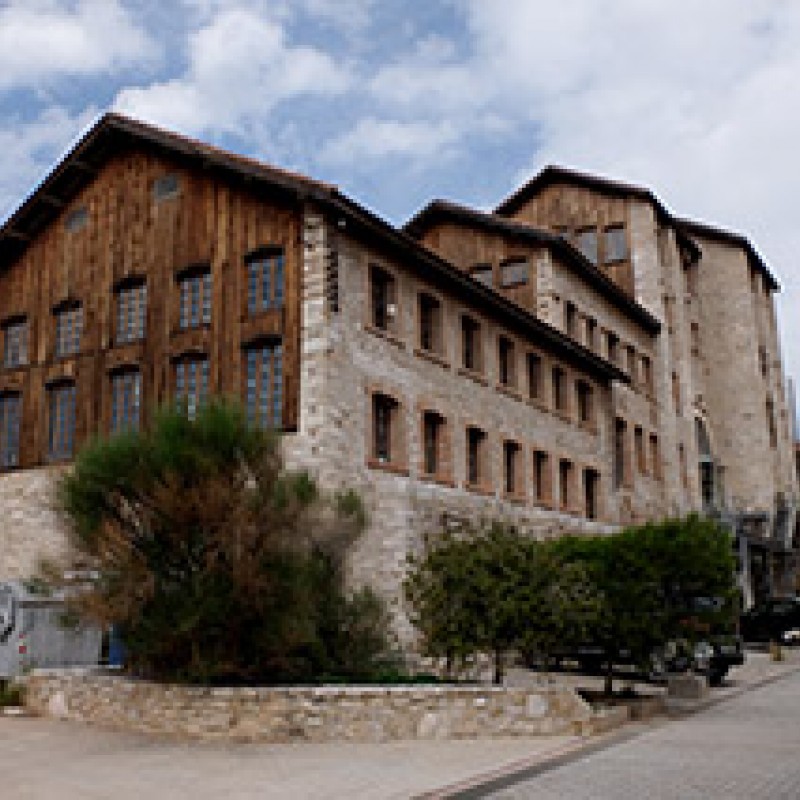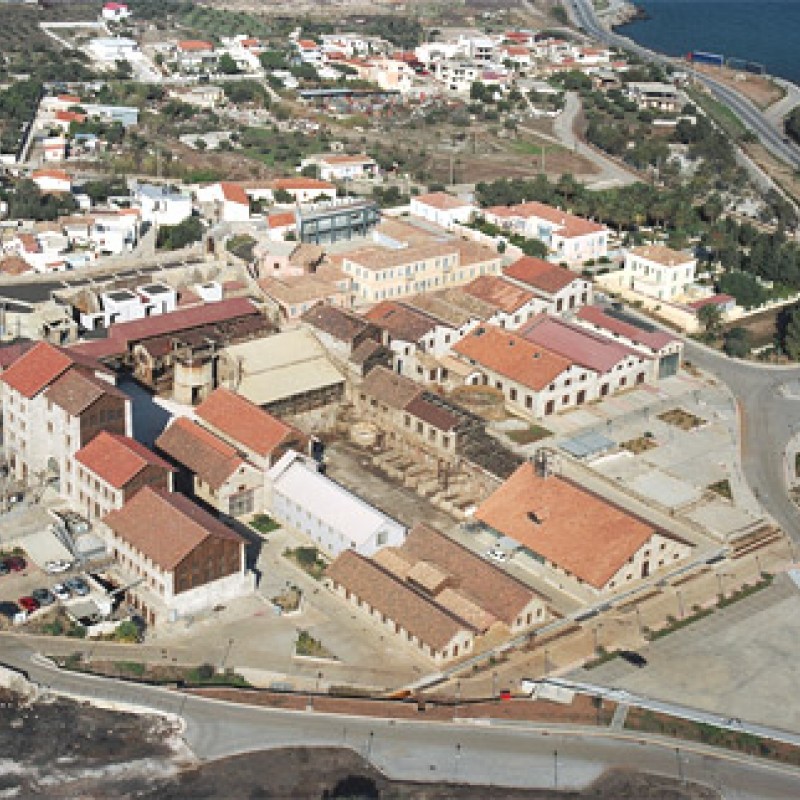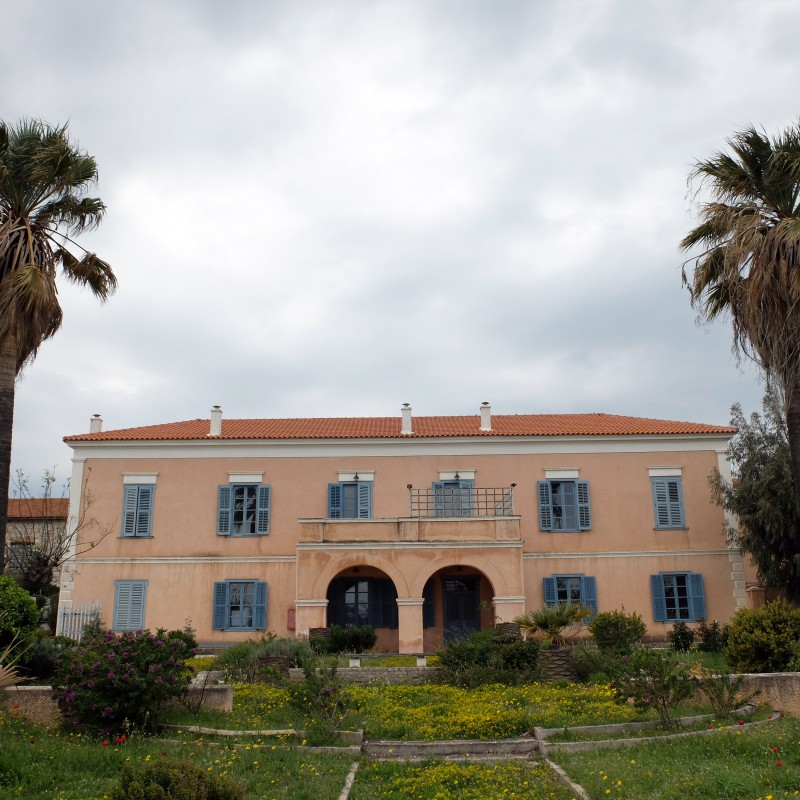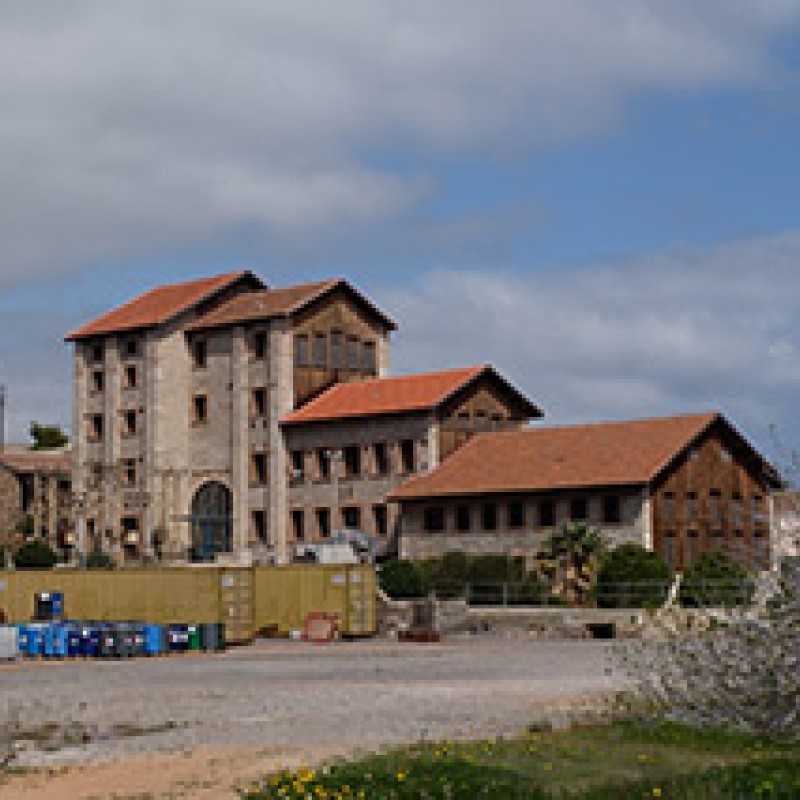Lavrion Technological and Cultural Park
Athens - Lavrion Avenue, 195 00, Lavrion, Greece
| Former Use: | Mining company |  |
| New Use: | Mixed use(scientific research, educational, business and cultural park) | |
| Category: | Culture, Education, HoReCa, Industrial Museum, Office, Workshop | |
| Website: | http://www.ltp.ntua.gr/contact_en | |
| Reuse Architect: | National Technical University of Athens | |
| Construction year(s): | 1875 - | |
| Reuse year(s): | 1994 - 1999 |
Description:
Historic use
The beginning of the mining activity in Lavrion, a town located c. 50 km southeast of Athens, can be traced back to 3.000 BC with the opening of the first mining tunnels. After its heyday in the classical times, the metallurgy activity of the area gradually went into decline and finally stopped in the 3rd century AC. The rediscovery and exploitation of the ancient silver and lead ores in the 1860s led to a new glorious era. The following century saw Lavrion’s transformation into the largest metallurgical centre of Greece and one of the biggest in the Balkans.
The most important development in the blooming industrialisation of the area was the establishment of the Compagnie Francaise des Mines du Laurium (CFML) in 1875. The mining company was founded by J.B.Serpieri, in the north entrance of the city of Lavrion, by the sea. Its massive growth gave way to multiple expansions and a constant renewal of its facilities. By the 1990s the company occupied an area of 25ha with 41 buildings and a built area of 45.000m2. (Touliatos and Efesiou, 2010, 13-14)
After WWII, following a declining course, it stopped the extraction activity in 1977 and started reducing its personnel until 1981 when it ceased operations. Under the pressure of the C.C. and the local community, the industry was undertaken by the newly established company Greek Metallurgical and Mining company of Lavrion. The company’s cease of operations in 1989 coincided with a violent process of deindustrialisation in the town. (Pogkas, 1996, 33-34) According to K. Pogkas, Mayor of Lavrion 1975-1994,
“Between 1990 and 1993, 70% of the industry left Lavrion. The city sank. In a period of 2.5 years, we lost 2,500 jobs out of the 3.500 of Lavrion. It was a city in despair.” (interview, 28/03/2017)
Reuse Preparation
In this climate of unpreceded socio-financial crisis, a liquidation and demolition of the complex of the French Mining Company (FMC) was scheduled. The destructive plan, which was about to deprive Lavrion from a landmark intertwined with its industrial history and its core identity, was forcefully challenged by the joint action of the Municipality, the local community and the National Technical University of Athens (NTUA).
The posed parties in order to safeguard the complex from the bulldozers and offer it a new life had to take three important steps: Firstly, pressure the Greek Government to purchase the site and assign it to the Ministry of Culture and the NTUA; secondly, devise a suitable new program for the complex; lastly secure funding for the required studies and works of its transformation. Albeit a challenging venture, the decisive efforts of the collaboration came into fruition.
In July 1992 the complex was bought by the Greek State and was assigned to the NTUA to transform it into a Technological and Cultural Park, while the buildings and the complex’s machinery were listed as national monuments by the Ministry of Culture. According to Prof. K. Panagopoulos, initiator of the project, “The new use was imposed by the site itself.” (interview, 08/05/2017) Assoc. Prof. N. Belavilas, coordinator of the transformation works and Board Member of the Lavrion Technological and Cultural Park (LTCP), adds:
“The new program was inspired by the wish for a continuation of technology, production and the sense of innovation that pre-existed on site. The cultural part emerged from the consideration that the identity of space cannot be separated from the notion of monuments and culture.” (interview, 10/07/2015)
The funding for the initial studies, the first stage of the complex’s transformation and the decontamination process came from a mixed scheme. In detail, 25% of the investment (€ 5.7 million) was covered by the Greek State while 75% (€ 17.1 million) came from European Union's Funds. The NTUA, invested 60.000€ in 1996 for the establishment of the Company for the Utilization and Management of the Property of the NTUA (CUMP-NTUA) providing administrative and technical staff as well. (Damigos and Kaliampakos, 2012, 175-176)
According to the testimonies of involved stakeholders (interviews, 2015 & 2017), an important problem during the preparation and reuse of the complex was the frictions within the team of stakeholders. N. Belavilas explains:
“There were very strong fluctuations in the political balance (within the team of stakeholders). I am not referring to changes in the central political scene but to those of the local authority and the NTUA. The changes in the Rectorate of the NTUA were causing very strong upheavals that were sometimes turning into conflicts. Accordingly, depending on these conflicts, from times to times the city of Lavrion was embracing the venture or it was withdrawing from it.” (interview, 10/07/2015)
Reuse process
The outcome of the transformation was shaped by the following array of decisions. First, it was decided to preserve the whole site, documenting, evaluating and safeguarding the complete entity of the production line along with the historic objects, engines, installations and the historic archive which was found on-site. Prof. I. Polyzos, Vice Rector NTUA 1994-97, elaborating on another decision, states:
“The second dilemma we had to face was the selection among the spaces which would work as a museum of themselves and those that would be used for hire.” (interview, 18/07/2017)
The third decision regarded the precise mix and allocation of the new uses that involved research and technology, production, education and culture and a small part of recreation and accommodation. The delivery of an economically autonomous project that would need no external funding for its operation was among the basic project’s decisions, as well. In order to ensure that, a business plan was devised by the NTUA project team and external consultants.
During the preparation of the works the project’s stakeholders faced another dimension which was originally underestimated. The issue of the buildings’ and soil’s decontamination, which was an unknown field at the time in Greece, was addressed with scientific rigor in two phases (1995-1997 and 2003-2009).(NTUA, 1997, 9, Kaliambakos, 2015, 125)
The in-depth study of the complex’s evolution along with the wish to produce a result of high architectural quality and social relevance within the available budget, dictated the concept of the transformation and its delivery strategy. The massive area was divided in three zones, corresponding roughly to the three ‘generations’ of the industrial facilities. It was decided to start the project with zone A, due to its historic characteristics (1876-1895) and its central location. The works for the transformation of this zone of 12.000m2, which included 14 buildings, started in 1995 and were completed in 1999. (Touliatos and Efesiou, 2010, 14)The transformation was realised with the direct involvement and oversight of an interdisciplinary team staffed mainly by NTUA professors, researchers and students from the School of Architecture and the School of Mining and Metallurgical Engineering.
Operation
LTCP opened its doors officially to the public in 1999 and was welcomed as a stepping stone towards the upgrade of the town. Since then, over 40 companies and educational foundations have been housed in the converted premises and more than 170 cultural events have been organised, including theatre, concerts and art events. Furthermore, over 20 conferences and 80 scientific meetings have taken place there while c. 2.000 students per year visit the complex. These activities are organised with a budget of c. 300.000 €/ year, without external funding, by a personnel of 10 people only. (Kaliambakos, 2015, 123-124) The LTCP operates as an individual legal entity of private right by the CUMP-NTUA. The sole share of the Company, is owned by the NTUA. (Lavrion Technological and Cultural Park, n.d.)
The project, which had a very innovative character for Greek standards, quickly attracted the private sectors’ attention. By 2008, more than 70% of the available space was rented mainly to high-tech companies. LTCP, along with significant infrastructure improvements in the wider area of Mesogia, put the former industrial town back into the map, offering it new opportunities for a socio-financial recovery. (Kaliambakos, 2015, 87)
Shifts
The financial crisis however, that hit Greece in 2008 influenced profoundly this progressive development, having a threefold negative effect in the Park’s operation. Firstly, no additional funds became available for the completion of the transformation of the rest of the complex. Secondly, the Park lost more than half of its tenants, with the hired space dropping to c. 30% and the working places cut to half, in comparison with 2007. Given that the rent was the main source of the Park’s revenue, this development resulted in serious problems in its operation and maintenance. fLastly, the continuation of the strategic development projects of the area that were expected to multiply positive effects for the Park and the town (i.e. prolongation of the suburban railway to Lavrion and extension of the port) was halted.
Nevertheless, in this hectic climate of crisis, the determined efforts of the local community, the management of the Park and the NTUA involved staff, have once again resulted in an important achievement. Within the following months, a project of enormous importance, which has been delayed almost two decades, will begin. It will include the transformation of the machinery building of the complex into the Lavrion Mining and Metallurgy Museum (LMMM). The works, with a budget of € 2,7 million, will be funded by the Region of Attika.
The LMMM is a project of historical, technological, cultural, research, educational and developmental interest which provides a rare chance for the refreshment of the Park and the attraction of a wider audience. (Dermatis et al., 2010, 90, NTUA School of Architecture Urban Environment Laboratory, 2009) Along with it, there are previsions for the move, conservation and opening to the public of the Historic Archive of Lavrion. This rare material, which is currently stored in the halls of the machinery building, has a heightened significance as it is the biggest industrial archive in the country.
Along with the completion of the aforementioned projects, the strategic plan of the LTCP (2015-2010) set as priorities: the decontamination of the building of Konofagos, a key project that has been delayed due to financial and bureaucratic reasons; the attraction of EU funding programs; the strengthening of its collaboration with NTUA laboratories, professional organisations and local bodies such as the Port Authority of Lavrion and the continuation of parallel actions compatible with the character of the Park that have been proven profitable. (Chadoumelis, 2015, 19)
Relevant Literature:
- Chadoumelis, A. 2015. Strategic analysis and planning (2015-2020): Updated version February 2016. Lavrion: NTUA, Lavrion Technological and Cultural Park
- Damigos, D. & Kaliampakos, D. 2012. Emerging Value of Brownfields Regeneration. International Journal of Sustainable Development and Planning, 7(2), 173 – 185.
- Dermatis, G., Marmani, M., Belavilas, N. & Chatzi-Rodopoulou, T. 2010. A twenty Year Debt in history: Mining and metallurgy Museum of Lavrion. TICCIH GR Journal, C.1, 88-91.
- Kaliambakos, D. 2015. The Contribution of the National Technical university of Athens in Lavrion of the 21st century, Athens University publications NTUA.
- Lavrion Technological and Cultural Park. n.d. Adminitration [Online]. Available: http://www.ltp.ntua.gr/lavrion_park/administration_en [Accessed 6 September 2017].
- NTUA 1997. Technological and Cultural Park of Lavrion: Studies and works 1994-97, Athens, University publications NTUA.
- NTUA School of Architecture Urban Environment Laboratory. 2009. Architectural and museological design of Lavrion Metallurgy and Metallurgy Museum [Online]. Available: http://www.arch.ntua.gr/envlab/resources#resource-5310 [Accessed 5 September 2017].
- Pogkas, K. 1996. How did we get to the Lavrion Technological and Cultural Park Sigchrona Themata, 58-59, 33-35.
- Touliatos, P. & Efesiou, I. 2010. 1992-2010- From the initial design to the restoration and reuse of the historic buildings in the Lavrion Technological and Cultural Park. In: 10. Tsilis, Y. (ed.) Architectural Footprints of industrial archaeology in Lavrion from documentation to reuse Athens: University publications NTUA.




